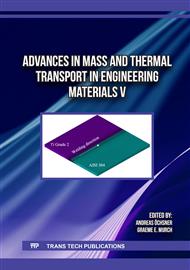[1]
S.V. Digonsky, V.V. Ten, Unknown hydrogen: the role of hydrogen in polymorphism of solids, processes of solid-phase reduction of oxides and sintering of powders, St. Petersburg: Nauka (2006), 292.
Google Scholar
[2]
O.N. Morozova, A.A. Pavlenko, S.S. Titov, Methods of hydrogen production, Yuzhno-Sibirskiy nauchny vestnik. 4 (29) (2019) 188-194.
Google Scholar
[3]
N.L. Solodova, R.R. Minigulov, E.A. Emelyanycheva, Hydrogen as a promising energy carrier. Modern methods of hydrogen production, Bulletin of Kazan Technological University. 18 (3) (2015) 137-140.
Google Scholar
[4]
Y.L. Ershov, A.G. Shakurov, V.M. Parshin, A.G. Kolesnikov, A.Yu. Shishov, Hydrogen era in domestic metallurgy. Message 1, Steel. 11 (2011) 50-55.
DOI: 10.3103/s0967091221110048
Google Scholar
[5]
Y.L. Ershov, A.G. Shakurov, V.M. Parshin, A.G. Kolesnikov, A.Yu. Shishov, Hydrogen era in domestic metallurgy. Message 2, Steel. 12 (2021) 48-56.
DOI: 10.3103/s0967091221110048
Google Scholar
[6]
Gas in metal production, https://stal-kom.ru/gaz-pri-proizvodstve-metalla, 08.11.2023.
Google Scholar
[7]
Germany launched the first production of steel on hydrogen, https://gmk.center/news/v-germanii-zapustili-pervoe-proizvodstvo-stali-na-vodorode, 18.05.2024.
Google Scholar
[8]
H. Suopajärvi, E. Pongrácz, T. Fabritius, Bioreducer use in Finnish blast furnace ironmaking – Analysis of CO2 emission reduction potential and mitigation cost, Applied Energy. 124 (2014) 82-93.
DOI: 10.1016/j.apenergy.2014.03.008
Google Scholar
[9]
Y. Liu, Ya. Shen, Modelling and optimization of biomass injection in ironmaking blast furnaces, Progress in Energy and Combustion Science. 87 (2021) 100952.
DOI: 10.1016/j.pecs.2021.100952
Google Scholar
[10]
S. Luo, Ya. Zhou, Ch. Yi, Hydrogen-rich gas production from biomass catalytic gasification using hot blast furnace slag as heat carrier and catalyst in moving-bed reactor, International journal of hydrogen energy. 37 (2012) 15081-15085.
DOI: 10.1016/j.ijhydene.2012.07.105
Google Scholar
[11]
H. Xie, R. Li, Zh. Wang, X. Yao, Q. Yu, Hydrogen production of bio-oil steam reforming combining heat recovery of blast furnace slag: Thermodynamic analysis, International journal of hydrogen energy. 44 (2019) 25514-25523.
DOI: 10.1016/j.ijhydene.2019.08.014
Google Scholar
[12]
C. Feliciano-Bruzual, Charcoal injection in blast furnaces (Bio-PCI): CO2 reduction potential and economic prospects, Journal of materials research and technology. 3(3) (2014) 233-243.
DOI: 10.1016/j.jmrt.2014.06.001
Google Scholar
[13]
V.K. Afanasiev, S.N. Gorlova, E.V. Kuznetsova, A.V. Sochnev, G.I. Efanov, V.N. Tolstoguzov, B.A. Kuskov, On the role of hydrogen in the blast furnace process of pig iron, Metal processing: technology, equipment, tools. 4 (25) (2004) 15-18.
Google Scholar
[14]
S.P. Rogozhnikov, I.S. Rogozhnikov, Determination of hydrogen utilisation degree in blast furnace, Ferrous metallurgy. Bulletin of scientific, technical and economic information. 10(75) (2020) 1129-1134.
DOI: 10.32339/0135-5910-2019-10-1129-1134
Google Scholar
[15]
M.S. Yalunin, G.Yu. Vitkina, A.N. Dmitriev, M.O. Zolotykh, R.V. Alektorov, Assessment of the influence of reducing gas with increased hydrogen fraction on the efficiency of blast furnace melting, Proceedings of X All-Russian Scientific-Practical Conference of Students, Postgraduate Students and Young Scientists "Thermal Engineering and Informatics in Education, Science and Production" with international participation". 2022, 185-190.
Google Scholar
[16]
L.N. Shevelev, Estimation of economic, energy and ecological efficiency of pig iron and steel production from ore-coal briquettes in electric steelmaking unit with the use of hydrogen fuel, Ferrous metallurgy. Bulletin of scientific, technical and economic information, 8(77), (2021) 918-924.
DOI: 10.32339/0135-5910-2021-8-918-924
Google Scholar
[17]
N.A. Vatolin, G.K. Moiseev, B.G. Trusov, Thermodynamic modelling in high-temperature inorganic systems, Moscow: Metallurgy (1994) 352.
Google Scholar
[18]
I.A. Rybenko, E.V. Protopopov, Thermodynamic modelling of iron reduction processes // Izvestia of higher educational institutions. V. Thermodynamic modelling of iron reduction processes, Izvestiya vuzov. Chernaya metallurgiya. 11(64) (2021) 825-831.
DOI: 10.17073/0368-0797-2021-11-825-831
Google Scholar


